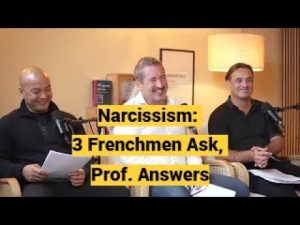1. Nature and Role of Narcissism
- Everyone possesses some degree of narcissism, which is necessary for healthy functioning and is likely influenced by genetics. Healthy narcissism underpins self-esteem, self-confidence, and self-worth, and drives ambition and achievement. [00:00]
- Narcissism serves as a channeling mechanism for various energies and motivations. [00:18]
- Pathological narcissism occurs when narcissism becomes malignant or destructive. [01:02]
2. Awareness and Treatment of Pathological Narcissism
- True narcissists are aware of their behaviors and their impact on others but are unaware of their underlying motivations. They create self-justifying narratives (egoonic narratives) to rationalize their actions. [01:20]
- Behavioral modification therapies (schema therapy, CBT, etc.) can change narcissist behaviors to make them less abrasive and antisocial, but these effects tend to be temporary without ongoing maintenance. [03:15]
- The main issue with narcissists is not just their behaviors but the narcissistic core and identity, which influences long-term interactions. [04:40]
3. The Narcissist’s “Fantastic Space”
- The narcissist creates a protective fantasy world (described as a “Disneyland”-like fantasy) isolating the victim from reality and idealizing the victim as perfect, gracious, and flawless. [05:00]
- This fantasy is intoxicating and addictive, enabling the victim to experience self-love for the first time. [05:40]
- The narcissist expects the victim to reciprocate through providing the “four S’s”: sex, services, supply (narcissistic or sadistic), and safety/stability. Providing two of these grants entry into the narcissist’s fantasy. [06:15]
- Within this fantasy, the victim is infantilized, losing personal agency and autonomy, becoming fully dependent on the narcissist. [07:10]
4. The Idealization and Devaluation Phases
- Victims often initially experience “love bombing” or idealization, which eventually leads to a painful “devaluation” phase, an inevitable transition. [07:50]
- The idealization phase can raise suspicion if the narcissist overdoes the praise with unrealistic or contradictory claims. [08:35]
- Devaluation is an inherent feature of narcissist relationships and precedes discarding the victim, driven by the narcissist’s internal dynamics rather than the victim’s actions. [09:40]
- Devaluation happens abruptly and arbitrarily, and even total submission on the victim’s part won’t prevent it. [10:50]
5. Final Notes
- There is no winning or fair resolution when dealing with a true narcissist; the dynamic is inherently manipulative and damaging. [11:30]
This summary covers the major discussion topics of the meeting and provides precise references to where each subject was addressed, allowing for easy review or further investigation.






